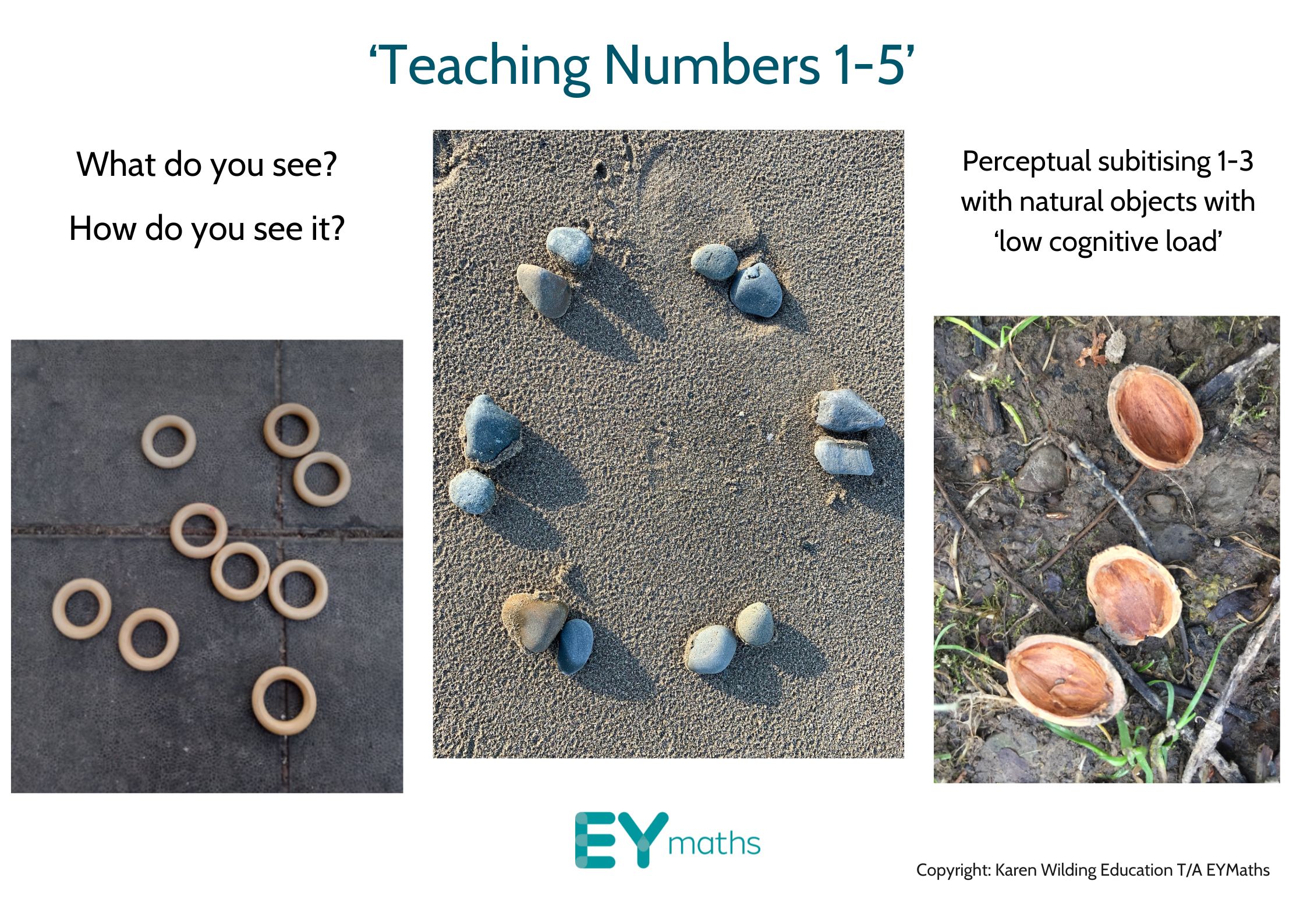
My class already recognise 1-5... but this is what the scheme says I should be teaching
Nov 21, 2024(Click on 'download external images to see full post)
This term, teaching 'Numbers 1-5' is the focus in many of our most well-known Maths schemes.
BUT what if you feel that your children already have this knowledge and are ready to move on?
From the posts shared on social media groups so far, there are many of you feeling a little conflicted.
Can you relate?
- You know that a deep understanding of these numbers is essential for children to progress with fluency and confidence
- BUT, you may also feel they're ready to move on. You've done so much work on 1-5 last term and you're worried they will become bored and disengaged?
How do you 'square this circle'?
If this resonates with you then read on...
(IMPORTANT: What I'll share with you here will be relevant to you if you teach 3-6 year olds+ too).
To know whether your children really ARE ready to move on, your first question needs to be:
- What are the key skills children with fluency and mastery of numbers 1-5 exhibit?
Without this evidence, you're building on sand.
Our formative assessment is everything AND it must be reliable and this reliability is based upon your own Maths subject knowledge and pedagogical understanding.
So let's unpick this question further to understand what's involved:
What ARE the key skills children with fluency and mastery of numbers 1-5 exhibit (so I know they're ready to move on)`?

1. Cardinality Using Subitising:
The 'how manyness ' of number and the skills that enables our children to understand addition and subtraction (and later multiplication and division), teen numbers, place value and more
The ability to:
- Shows understanding of 'more' and 'less/fewer' by being making deliberate choice between larger and smaller amounts, being unhappy with lack of fairness or by adjusting amounts to create equality
- Replicates equal amounts accurately e.g. you collect 2 strawberries and they do the same
- Collects remaining amount needed to complete a set of something or required amount
(All three of these example above do not require any use of number names to demonstrate number sense)
- Perceptually subitises amounts 1-3 in a random arrangement (involving natural and manmade items with low cognitive load and involving concepts of 'more/less/fewer')
- Perceptually subitises amounts of 1, 2 and 3 within larger groups (involving natural and manmade items with low cognitive load and developing part/whole understanding)
- Recognise the visual 'concept images' of 1-3 on a 5 frame (involving 1 more and 1 less, part whole and relationships within 5 - 'full, not full yet'/unitising)
- Conceptually subitise amounts 1-3 (further developing part/whole and introducing addition and subtraction)
- Introducing 4 through reasoning of its parts e.g. 'It's more than 3 because it has a 2 and a 2 in it and 3 only has a 2 and a 1 in it' etc.
- Perceptual subitising 4 on a 5 frame as a concept image by noticing 'only need 1 more to finish the 5 frame'
- Conceptual subitising of 4 finding parts within the whole (extending beyond 2 parts e.g. 'I can see 1 and 1 and 2')
- Introducing 5 through reasoning of its parts e.g. 'It's more than 4 because it has a 2 and a 2 and a 1 in it and 34only has a 2 and a 2 in it' etc.
- Perceptual subitising 5 on a 5 frame as a concept image by noticing 'it's full/finished!'
- Conceptual subitising of 5 finding parts within the whole (extending beyond 2 parts e.g. 'I can see 1 and 2 and 2'

2. Counting for Ordinality: (NOT 'counting for cardinality' to see why visit our YouTube channel and look for 'Why Counting Doesn't Make Sense to Young Children')
The ability to:
- Sing songs, say rhymes and join in with actions etc. involving numbers in order from 1-5 (forwards and backwards and starting at numbers other than 1 and 5)
- Match actions to numbers e.g. when doing 3 claps, claps on each number said '1, 2, 3!' (1:1 correspondence)
3. Ordinality (Number names meaning 1st, 2nd, 3rd) etc.
- Understands that when we talk about the third child in the line as '3' it doesn't mean we're saying they're 3 years old' or that they are 3 children (when they are only 1 person)
4. Nominality:
- Understanding that a number can be a label e.g. 'I'm 4!' and it doesn't mean there are 4 things or the next child has to be 5 (then 6 etc.)
5. Recognising Numbers as Symbols:
This is all too often used as evidence of a child's fluency and mastery in number sense 1-5 but, although important, judging a child as understanding numbers 1-5 by their ability to read a digit is like saying someone understand what a cat is because they can read the word 'cat'.
Children will begin to fluently recognise and say the names of digits they see as meaningful (and also see regularly) using rhymes, books, you writing digits to represent amounts make learning this an integral (and easy for most) part of their digit recognition
6. Writing Digits 1-5
Its exactly the same as above. Being able to write a digits no evidence of number sense. Being able to write a digit and as a label for your age, to denote an amount or explore a number pattern, however, is.
Write numbers yourself in front of children with purpose as well as playfully (Greg Botrill's 'Drawing Clun' is perfect for this) and you'll find the, exploring mathematical mark making as an integral part of their play.
How do you feel now?
- Are you suddenly aware of 'what you didn't know you didn't know'? (Yet!)
- Are you feeling overwhelmed or a little scared wondering where on earth you start to put this into practice? (That's where we all started)
- Or have you been on a journey from not knowing to enlightenment in recent times and now this list makes complete sense and it a really useful guide to assess where your children are and where your attention needs to go next?
Those of you already training with me in Pathway, IMPACT and Team IMPACT will either choose '3' or be on the road that will get you there very soon.
If you chose 1 or 2 then I may be able to help you
On 17th January 2024 (a week and a half away at the time of writing), we'll be launching our brand new 10-day 'Teaching Numbers 0-20 Mini-Maths Adventure' where I'll be not only making sure all of my members understand how to embed everything written above, BUT, I'll be extending this from 0- 10, into the 'teen' numbers (which I can make not 'tricky' to teach!) and then all the way to 20 making it PERFECT for educators of 3-6 year olds
EXCITED? Love to join me and my fantastic members and learn with us?
Here's just one of the resources I'll be sharing with you and talking you through

'Teaching Numbers 0-20 Mini-Maths Adventure' for educators of 3-6 year olds wherever you are in the world!
Online, live sessions with Karen Wilding (all recorded), your opportunity to be energised and inspired by learning within a community of like-mined practitioners!
To join us, you have 2 easy options:
1. All of my Pathway, IMPACT and Team IMPACT members receive FREE and unlimited access (beyond the training itself)
2. You can simply join us just for the training experience itself
Links:
Try out Pathway (£15p/m) or IMPACT (£25p/m). No tie-in; cancel any time.
Link: https://www.eymaths.co.uk/pathway-and-impact
Choosing this first option means you're actually getting your first month in the membership (with all of the amazing benefits included) completely FREE (No brainer!)
Or simply join us just for the 10-day 'Teaching Numbers 0-20 Mini-Maths Adventure' (for a tiny fraction of the cost of one-off live training)
Link: https://www.eymaths.co.uk/teaching-numbers-1-20-mini-maths-adventure
Questions? Not a problem
Simply click HERE to email (or on the Contact Us' option on the website menu) and we'll be straight back to you.
Don't miss a beat!
New moves, motivation, and classes delivered to your inbox.
We hate SPAM. We will never sell your information, for any reason.

